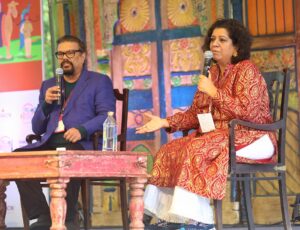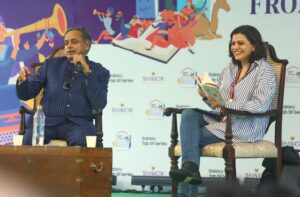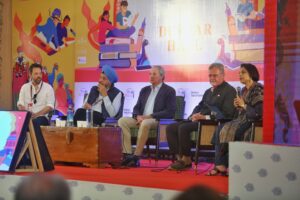Demystifying the Perfect Biryani with Krish Ashok
4 min read
Krish Ashok, author of Masala Lab, addresses the audience at the Qissewale session in Jaipur
If you have come across the popular handle ‘Masla Lab’ on Instagram, you already know Krish Ashok for his debunking of food myths. While one would be inclined to believe so, the author of the eponymous book, Masala Lab, Krish is not a chef. He heads the advisory and consulting function of the AI.Cloud unit at TCS. Self-admittedly, he has been doing that since age 13 and still cooks daily.
Krish stopped by in Jaipur last week to speak at the third session of Qissewale organised by Siyahi and hosted at the Hyatt Regency Jaipur Mansarovar. With a live demonstration of biryani cooking in the backdrop, Krish unveiled his recipe for the perfect dish, and talked about his experiments to de-exoticise Indian cooking.
Reading Between Biryani Layers
At the session, Krish deconstructed the art of creating the perfect biryani, delving into its regional variations and the secrets behind its captivating flavours. Krish’s discourse was a delightful blend of storytelling and scientific exploration. He emphasised the crucial role of fats, spices, and the intricate layering technique in achieving biryani nirvana.

The humble bay leaf, for instance, took centrestage as Krish explained its ability to infuse subtle yet significant depth of flavour. He then shed light on the fascinating art of “blooming” spices in fat, unlocking the secrets to achieving the ideal biryani texture and aroma.
Krish’s exploration ventured into the historical roots of these aromatic treasures. He unravelled the etymology of terms like “dalchini,” tracing their journeys from distant lands to become an integral part of the Indian culinary landscape.
Krish compared the art of layering spices in Indian cuisine to the making of a fine perfume, where each note unfolds in a captivating sequence. Like top notes in a perfume provide an initial burst of freshness, Ashok explained how chefs employ vibrant spices like cardamom and black pepper to awaken the palate. These are followed by the middle notes, exemplified by warming cinnamon and star anise, adding depth and complexity to the flavour profile. Finally, the base notes, like the earthy musk of cumin and the subtle heat of chilies, provide a long-lasting foundation that ties the symphony together.
Biryani, the quintessential Indian dish, is a symphony of fragrant rice, tender meat, and warm spices. Its aroma evokes memories of family gatherings and festive celebrations. But beneath this delicious layer lies a complex history and a science of flavours waiting to be unravelled.
The Science Behind A Pineapple’s Bite

Krish then went on to paint a vibrant picture of the fragrant world of spices. With a touch of amusement, he shared how Christopher Columbus’s misidentification played a role in the naming of pepper and chillies.
Krish shed light on the fascinating world of plant defence mechanisms and their interactions with our taste buds. “Plants have learnt every trick in the book to prevent animals from eating them. They try different kinds of poisons. They try different kinds of thorns. How does your tongue react to pineapple? It probably feels a tingle. That is because pineapple has an enzyme that tries to digest you when you eat it, making it a fruit that ‘eats you.’ So while you’re eating the pineapple, it is trying to eat you back!” Krish shared that this very quality makes it an excellent tenderizer for meat.
Krish also warned the audience about the use of spices. “Spices are fantastic in small quantities but toxic in large amounts. Take nutmeg, for example. You could get high on nutmeg. Of course, you would need to consume a significant amount for that. It can even make you sick. This is why it has been added to babies’ milk in India. It helps put them to sleep!”
Likewise, he suggested, one should bear caution while using cinnamon. “Small quantities in a tadka is fine, but if you regularly eat cinnamon or add powdered cinnamon, ensure you get the real thing. The one available in stores is usually cassia that contains a large amount of coumarin, which can be toxic in large quantities.”
The Chapati Patriarchy

With an interesting insight into the country’s patriarchy index, the author shared how higher levels of patriarchy corresponded with the staple diet of people in the regions. Rice-eating regions, including the south and the northeastern parts of the country, have lower levels of patriarchy.
“You can cook rice in one shot for the entire family. But chapati has to be made freshly hot for every man in the house, as and when they eat. So the average time spent in the kitchen for a North Indian woman is upward of 4-5 hours. The average time spent in the kitchen by a South Indian woman is about 45 minutes!” he said.
Celebrating India’s rich culinary heritage, Krish’s talk was a reminder of the cultural tapestry woven with aromatic threads of spices, the ingenuity of generations of home cooks, and the stories whispered through every delectable bite.
The talk was followed by a specially-curated hi-tea experience celebrating the diversity of flavours, textures, and cooking techniques found around the world.



